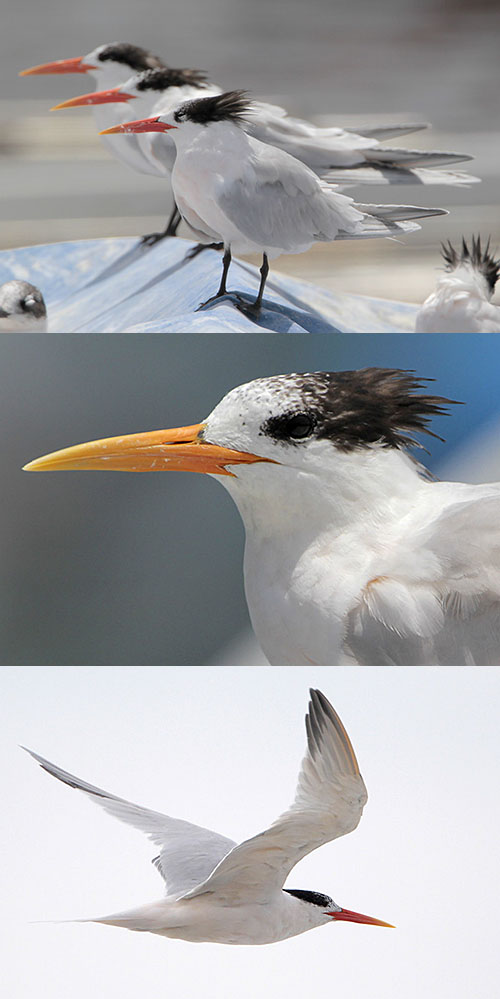Breeding only in a few local areas of southern California, the Elegant Tern barely qualifies as breeding in the U.S., but it does occur more widely in the state during a period of post-breeding dispersal each summer. Nesting in tight colonies, only a small area around each nest is defended a by a pair of Elegant Terns.
Elegant Terns are thought not to breed until they reach three years of age, and it is expected that they have long lifespans, though there is little actual data to evaluate this. High tides can wash away nests, and competition for nests sites occurs with several gull and tern species.
On this page
Description of the Elegant Tern
BREEDING MALE
The Elegant Tern has pale grayish upperparts, white underparts, a black cap, black legs, and a long, reddish bill. Length: 17 in. Wingspan: 34 in.

Photograph © Greg Lavaty.
Female
Same as male.
Seasonal change in appearance
Winter birds have white foreheads.
Juvenile
Juveniles resemble winter adults.
Habitat
Coasts and beaches.
Diet
Fish and small crustaceans.
Behavior
Forages by flying over water and plunging in to capture prey.
Range
Breeds locally along the west coast of Mexico and California and wanders north post-breeding. Winters from Mexico to South America.
More information:
Bent Life History
Visit the Bent Life History for extensive additional information on the Elegant Tern.
Wing Shape
The shape of a bird’s wing is often an indication of its habits and behavior. Fast flying birds have long, pointed wings. Soaring birds have long, broad wings. Different songbirds will have a slightly different wing shape. Some species look so much alike (Empidonax flycatchers) that scientists sometimes use the length of specific feathers to confirm a species’ identification.
Wing images from the University of Puget Sound, Slater Museum of Natural History
Fun Facts
Within 6 days of laying, adults are able to recognize their own egg.
Elegant Terns occasionally lay eggs in Caspian Tern nests. Some of these eggs may actually hatch and the young fledge.
Vocalizations
The call is described as a sharp “kee-rick”.
Similar Species
Royal Tern
Royal Terns have slightly shorter, thicker bills.
Caspian Tern
The bill of the Caspian Tern is thicker and often redder than the Elegant Tern.
Nesting
The nest consists of a shallow scrape on bare ground.
Number: 1-2.
Color: Buff or white with darker markings.
Incubation and fledging:
– Young hatch at 25-29 days.
– Young fledge (leave the nest) within days after hatching but remain with the adults for some time.
Bent Life History of the Elegant Tern
Published by the Smithsonian Institution between the 1920s and the 1950s, the Bent life history series of monographs provide an often colorful description of the birds of North America. Arthur Cleveland Bent was the lead author for the series. The Bent series is a great resource and often includes quotes from early American Ornithologists, including Audubon, Townsend, Wilson, Sutton and many others.
Bent Life History for the Elegant Tern – the common name and sub-species reflect the nomenclature in use at the time the description was written.
STERNA ELEGANS (Gambel)
This beautiful tern well deserves its name, for in color, form, and behavior it is certainly one of the most elegant of our sea birds, the most exquisite member of the charming group of “sea swallows.” Unfortunately, owing to its remote habitat, it has been seen in life by very few ornithologists. Many handsome specimens have found their way into collections, but the dried skin can give but a faint impression of the grace and beauty of the living bird. Not all of the few collectors who have explored the coasts of the peninsula of Lower California have succeeded in finding it, and still fewer have seen it on its breeding grounds. Consequently very little is known of its life history and habits. Probably Mr. Wilmot W. Brown, jr., has been more successful than anyone else in the pursuit of this rare species, and we are indebted to him for practically all that we know in regard to its nesting habits.
Nesting: Mr. Brown obtained a fine series of the eggs of this species for Col. John E. Thayer (1911a), who published a brief account of its nesting habits on Cerralvo Island, Lower California. He says:
The nests were slight depressions In the sand on the beach about 20 yards from the surf on the protected or land side of the island.
The eggs “were taken April 9 and 15, 1910. Most of the eggs were slightly incubated. One egg is generally what they lay, sometimes two, but only rarely.”:
Eggs: Mr. Thayer’s beautiful series of 18 sets, of one egg each, makes an attractive display of striking variations. The eggs suggest those of the Cabot’s tern rather than those of the royal tern. They vary in shape from ovate to elongate ovate. The ground color is very light, varying from “pinkish buff” or pale “pinkish buff~~ to pure white, with a decided tendency toward the latter. The commoner types are spotted like eggs of the royal tern, but more sparingly. Some are very heavily and boldly marked with great irregular blotches of various shades of the darker browns, often almost black. These dark markings frequently have the appearance of having been washed out on the edges. One pink egg is uniformly covered with small spots of very dark brown and pale shades of “violet gray.”:
Another pink egg is blotched with “pale violet gray,” overlaid with large handsome blotches of “chestnut,” “chocolate brown,” and “chestnut brown “óa beautiful egg. The measurements of 27 eggs, in various collections, average 53.5 by 38 millimeters; the eggs showing the four extremes, measure 57 by 39, 55 by 40.5, and 51 by 35.5 millimeters.
Plumages: As I have never seen a specimen of the downy young or any birds in the immature plumages, I can not say much in regard to the sequence of plumages to maturity, but it seems reasonable to assume that all the plumage changes are similar to those of the closely related royal tern.
Behavior: I have never seen the elegant tern in life and can not find anything in print regarding its habits, but probably its behavior is not very different from that of the royal tern, which it so closely resembles in appearance.
Fall: The elegant tern is another one of the Lower California species, which has adopted the peculiar habit of migrating northward at the close of the breeding season, wandering occasionally as far as Monterey or San Francisco.
DISTRIBUTION
Breeding range: So far as known only in the Gulf of California, Mexico (San Pedro Martir, and Cerralvo Islands, and near Guaymas). Winter range: From central California (San Francisco Bay) southward along the coast to Chile (Coquimbo Bay, Valdivia, and near Valparaiso).
Spring migration: Returns to its breeding range in March and April. Lower California, La Paz, April 12 to 27.
Fall migration: Southward to Peru (Callao Bay) in September. Northward to California at about the same time: San Francisco Bay, September 17; Monterey Bay, September 22 to October 29; Point Pinos, September and October.
Casual records: Accidental in Texas (Corpus Christi).
Egg dates: Gulf of California: Seven records, April 1 to May 1; four records, April 9 to May 1.


